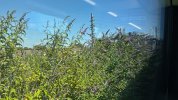Envoy
Established Member
- Joined
- 29 Aug 2014
- Messages
- 2,848
If Network Rail were to act now by hacking down the Buddleia bushes before they set seed, they would help prevent the seeds blowing to create new plants. When the cut down Buddleia’s start to regrow, then they should spray them to knock them out.
Photo below shows the situation yesterday by the Canton depot in Cardiff. Clearly no effort is bing made to control these invasive shrubs which wreck masonry.
Photo below shows the situation yesterday by the Canton depot in Cardiff. Clearly no effort is bing made to control these invasive shrubs which wreck masonry.
Attachments
Last edited:

